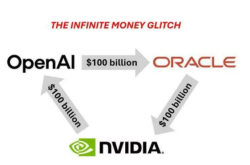Who Will Be the Next Pioneer in the AI Field? | Industry Insight
![]() 11/17 2025
11/17 2025
![]() 431
431
Since the latter half of 2023, 25 AI-related firms have made their debut on the Hong Kong Stock Exchange through IPOs, with five AI companies successfully listing in the first half of 2025 alone. Clearly, the AI sector is emerging as the most reliable growth engine in the capital chain.
Capital never operates without a clear target. What characteristics do these 'AI favorites' chosen by investors share? Which areas of implementation hold the greatest potential for real-world profitability? And how should companies aiming to become the 'first AI stock' navigate their path?
Author | Dou Dou
Editor | Pi Ye
Produced by | Chanyejia
In 2025, AI stands out as one of the few areas still brimming with both certainty and imagination, drawing an intensified convergence of capital, talent, and storytelling.
According to IT Juzi data, as of the third quarter of this year, 764 AI companies have secured venture capital investments, reaching a new five-year peak with total transaction amounts hitting 83 billion yuan.
On the surface, the primary market is heating up, but in reality, there are limited investable sectors, with funds still predominantly focused on the AI field, creating a unique investment landscape.
This 'concentrated heat' phenomenon is not confined to the primary market. IPO trends in the secondary market also underscore AI's capital allure. According to LiveReport big data, since the latter half of 2023, 25 AI-related companies have gone public on the Hong Kong Stock Exchange via IPOs, with five AI companies successfully listing in the first half of 2025 alone. It is evident that the AI sector is becoming the most reliable growth point in the capital chain.
Capital never operates without a clear target. What characteristics do these 'AI favorites' chosen by investors share? Which areas of implementation hold the greatest potential for real-world profitability? And how should companies aiming to become the 'first AI stock' navigate their path?
These questions encapsulate the key challenges for the next stage of competition in the AI industry.
I. The 'AI Favorites' Chosen by Capital
Compared to 2024, AI companies selected by capital this year are notably more pragmatic.
According to Chanyejia statistics, in the first three quarters of 2025, there were 548 transactions in the primary market for artificial intelligence, marking a year-on-year increase of 44.59%. Specifically, in terms of sub-sectors, general AI applications and industry-specific AI applications account for nearly half, emerging as the two most rapidly growing mainlines. In terms of transaction amounts, industry-specific AI applications have surged to become the most capital-intensive sector, reaching 15 billion yuan.
This trend starkly contrasts with last year's capital frenzy in the AIGC layer.
During the same period in 2024, the transaction amount in the AIGC sector reached 30.8 billion yuan, accounting for 60% of the total. This year, that figure has plummeted to 11.1 billion yuan, representing a year-on-year decrease of 64.01%. Capital's 'cooling' towards AIGC has directly dragged down the overall AI transaction amount, resulting in a mere 46.064 billion yuan in transactions in the first three quarters of 2025, a year-on-year decrease of 8.43%.
However, funds have not exited the market but are flowing more precisely into 'implementable' areas.
Capital is allocating more resources to three major directions: general AI applications, industry-specific AI applications, and foundational AI technologies, with growth rates of 216%, 36.8%, and 153.74%, respectively. It's worth noting that although the foundational layer has received more financing, this is partly due to the heavy equipment and high investment requirements in this field. Capital is not contracting but adjusting its allocation to place money where it can be more effectively converted into productivity.
A deeper analysis of companies that received over 100 million yuan in financing in the primary market during the first three quarters reveals that most focus primarily on specific application scenarios such as healthcare, logistics, autonomous driving, robotics, and digital marketing. Capital is clearly returning to a principle where AI must be 'down-to-earth.'
Now, let's turn our attention to the secondary market in the AI field.
As of July 2025, five companies have successfully gone public in the secondary market, covering areas such as warehousing and logistics, solutions, and unmanned mining trucks.
On the surface, these companies also fall under industry applications, but the difference is that IT Juzi categorizes these companies under the foundational AI layer and the AI technology layer. Furthermore, these companies generally possess robust profitability. For example, Geek+ reported revenues of 1.025 billion yuan, a year-on-year increase of 31.0%, thanks to the successful commercialization of AI in warehousing robots. CloudVoice, although experiencing slower overall profit growth, saw its Shanhai large model generate nearly 100 million yuan in revenue, a year-on-year surge of 457%. This demonstrates the amplifying effect of AI technology within existing business systems.
It's worth noting that, whether in the primary or secondary market, most of these 'AI favorites' do not possess a 'pure' AI attribute.
In other words, AI is not their sole label, and most are not native AI companies. Minglue Technology still focuses on government and enterprise digitalization, knowledge graphs, and intelligent decision-making as its main businesses. CloudVoice, established in 2012, has also undergone positioning changes. Deepexi's foundation lies in data analysis. In the primary market, truly 'pure AI' companies are rare, and the few that exist are backed by giants or have the support of mature industry chain resources. For example, BetterYear is backed by Alibaba, and Intent AI has received strategic investments.
Similarly, winners in the secondary market are often those that have deep roots in their industries and leverage AI to achieve leapfrogging.
This reveals an intriguing phenomenon: whether in the primary or secondary market, capital is not betting on AI itself but on 'AI-enabled companies.' Companies that truly move towards IPOs have clear commercialization paths.
II. The Real Pulse of AI Implementation in Industries
Capital's choices are never isolated events; they reflect the market's collective judgment on the ease of implementation.
Looking back at the years when the AI technology boom hit, the most and fastest technological implementations occurred at the interface layer. These implementations were concentrated in scenarios such as programming development, customer service, office work, and content marketing, which feature 'low risk and high frequency.' AI in these areas has improved operational efficiency, reduced labor costs, and quickly provided enterprises with a positive return on investment (ROI).
For example, in programming development scenarios, a study by GitHub shows that AI programming assistants can increase the speed at which developers complete tasks by approximately 26%. AI excels not only in code completion, unit test generation, and logic optimization but also participates in preliminary code reviews.
However, as AI enters higher-order development stages, its shortcomings gradually become apparent. An experiment by MIT points out that for senior developers, AI's productivity enhancement is only 8% to 13%. In some scenarios, AI guidance even extends development time by 19%.
This explains why, in the primary market, many AI startups focusing on interface-layer applications appear highly sought after in the early stages but struggle to sustain revenue growth. Low technical barriers, strong service substitutability, and severe homogenization are systemic challenges in this sector.
These interface-layer AI transformations can only unleash true productivity when deeply integrated with business processes. Some enterprises have recognized this and begun embedding AI into their core business chains. As a result, in fields such as healthcare, finance, education, logistics, and retail, the focus of AI is gradually shifting towards process-layer transformations.
The healthcare industry is a typical example. The four-quadrant model proposed in the Alibaba Cloud White Paper shows that medical imaging diagnosis and drug development fall into the 'high maturity + high potential' quadrant, with the commercialization rate of medical imaging AI products reaching 90%. Insilico Medicine's generative AI platform has compressed antibody development cycles by 10 times, achieving four drug licensing collaborations with a total amount exceeding 1.5 billion US dollars. This year, the company secured multiple large-scale financings.
AI implementation in the healthcare industry is not limited to research and development. BD optimizes inventory management through predictive analysis, improving forecast accuracy by 20% and significantly reducing inventory costs. Senyi Intelligence's smart hospital solutions reduce doctor documentation time by 50% through AI-driven medical record generation and quality control. Siemens' AI platform enhances diagnostic accuracy while improving radiology workflow efficiency by 40%, achieving collaborative optimization.
The commonality behind these cases is that AI is no longer just a tool but a decision-making variable embedded within the system. Once integrated into processes, it becomes the deepest moat for enterprises and, consequently, the direction capital is most willing to bet on.
However, process-layer transformations are not easy. Firstly, data is scattered across different systems within enterprises, and formats are not unified, requiring extensive cleaning and labeling for AI models to understand. Secondly, organizations must delegate decision-making processes to algorithms, which means management must relinquish control. Most enterprises are still in a 'dual-track' state of 'AI + manual,' where model decisions still require manual verification.
The healthcare scenario highlights this complexity. Issues such as data bias, insufficient interpretability, ambiguous ethical responsibilities, and complex process integration mean that AI currently primarily undertakes roles in quality control, imaging interpretation, and doctor-patient communication in the healthcare industry, with a significant distance remaining from 'independent diagnosis.'
However, from a technological perspective, this is still not the end of AI implementation.
The true value of AI lies in redefining business logic. This layer is not about tool upgrades or process optimizations but about reshaping the entire system's operational mechanism. Autonomous driving, embodied intelligence, and AI-guided shopping systems like those built by JD.com and Kuaishou, as well as Alibaba International's 'AI Partner,' are all essentially exploring AI-native organizational and operational methods.
But this step is also the farthest. It requires not only high-quality data and massive computational power investments but also years of engineering implementation validation. Currently, few companies can enter this layer, with most still in laboratory validation or local pilot stages.
Overall, interface-layer AI faces challenges in sustained monetization, business logic redefinition-layer AI invests in the future, while process transformation-layer AI may represent the most easily realizable commercialization interval at present.
This explains why there are extremely few truly 'pure AI' companies in the primary market, and most companies listed in the secondary market categorized as 'AI concept stocks' are actually combinations of 'AI + years of industry experience.'
III. Searching for the Next IPO Star in the AI Wave
In the AI field, the next bell ringer is accelerating its arrival.
Data shows that as of July 24, 2025, 214 companies have submitted listing applications to the Hong Kong Stock Exchange, with 48 being AI-related companies, accounting for 22.43%. In other words, one out of every five prospective listed companies is related to AI.
More interestingly, among these 48 AI concept prospective listed companies, 11 are A+H companies, accounting for a high 22.92%. This means that a group of 'leading enterprises' in the AI field with mature technologies, clear commercialization paths, and international layout capabilities have emerged. They are solidifying their capital foundations and amplifying their global influence through dual listings.
Among the countless contenders vying for supremacy, who will stand out and become the next true industry bell ringer?
Looking back at the batch of AI companies that successfully entered the capital market around 2025, an implicit consensus can be observed: the implementation path should 'start from a point and expand to a surface,' and the technological approach should 'begin with a scenario.'
Whether it's CloudVoice's medical AI, Minglue's marketing AI, Geek+'s warehousing robots, or Sine Drone's port autonomous vehicles, almost all follow a similar trajectory: starting from a business scenario with high certainty, deeply exploring needs, refining products to achieve industry leadership, and then gradually expanding horizontally into adjacent fields.
CloudVoice chose medical record quality control and subway voice ticketing as its breakthrough points. By establishing benchmark projects, it built early user perceptions of usability and effectiveness, providing practical leverage for the subsequent expansion of general-purpose large model applications. Haizhi Technology followed a similar path, using knowledge graph technology to enter the financial anti-fraud scenario and gradually extending its capabilities to operational risk control and data governance, achieving a virtuous cycle of 'scenario breakthrough - platform precipitation.'
These AI companies also generally avoid direct competition with general-purpose large models in their commercialization path choices, instead adopting a 'verticalization + specialization' strategy.
It is worth noting that this batch of AI companies at the forefront of 'ringing the bell' also share a commonality: they almost all invested in building their own platform-based products or foundational technology architectures at an early stage.
Take CloudVoice as an example. It boasts a self - developed large - scale model platform dubbed the "CloudVoice Brain" and a voice chip named Atlas. Deepexi, on the other hand, has constructed two platforms: FastData and FastAGI. These platforms correspond to data engines and intelligent engines respectively, playing distinct yet complementary roles.
Minglue has also made significant strides. It has built a comprehensive AI operation system that spans the entire process from analysis to decision - making. This system is established between its "Second Count System" and "Xiaoming Assistant", creating a seamless flow of information and operations.
Geek+ and Sine Drone have taken a different but equally innovative approach. They have developed full - stack solutions that integrate hardware and software around AI application scenarios. This integration enables them to achieve end - to - end closed loops, covering every step from algorithms, perception, and decision - making to execution.
These autonomous platforms offer a multitude of benefits. On one hand, they solidify core algorithms, models, and toolchains, thereby forming formidable technological barriers. These barriers act as a shield, protecting the companies' unique technological advantages in the competitive market. On the other hand, they streamline the process of standardized product replication. By doing so, they significantly reduce project delivery costs, making the products more cost - effective and competitive.
For AI companies, these platforms mark a crucial stage in their development journey. They represent the transition from labor - intensive projects to productization and large - scale (Note: "scaling" here refers to the process of expanding operations and reaching a wider market) development. The more powerful the platform capabilities are, the greater control the companies have over the commercialization rhythm. This means they can better time their product launches, market penetrations, and overall business strategies to maximize profits and market share.
According to predictions made by IDC and other reputable institutions, the Chinese AI solutions market is set for robust growth. Over the next five years, it is expected to maintain an annual growth rate of over 50%. By 2030, the market scale is projected to exceed 1 trillion yuan. This presents both a colossal opportunity and a fiercely competitive battleground for AI companies.
In the era of large models, where technology is evolving at an unprecedented pace, companies face intense competition. To stand out and avoid being lost in the sea of homogenized products, they must possess unique scenario data and specialized know - how. Only in this way can they resist the pressure of homogenized competition and emerge as industry leaders, ringing the bell of success in the highly competitive AI market.







